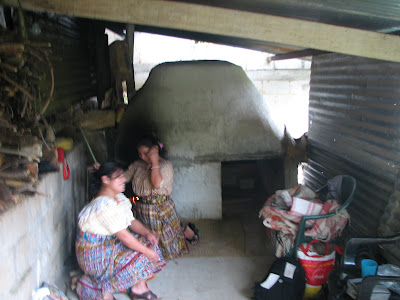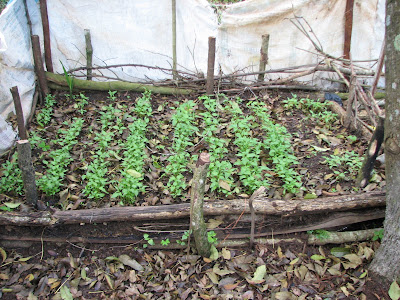 Congratulations Charlie on your 9-point buck. Those veggies from the garden finally paid off this year to fatten up this big guy.
Congratulations Charlie on your 9-point buck. Those veggies from the garden finally paid off this year to fatten up this big guy.This past month, as I knew it would, flew by. It was marked by 2 visits to the beach (one by myself just last weekend as a reward for all the work I had done and one with my entire training class during the independence day weekend before our Close of Service Conference), a 3-day close of service conference (at a beautiful hotel in Antigua) for everyone that was leaving in November, 1 week of field-based training that was held in Jalapa with 3 of those days in the town where I worked, 2 weeks of training near Antigua and the Peace Corps HQ, along with 2 friends (one from the states, and the other from Germany) who went a long for part of the ride for a week or more. The training for me was hard and meant a lot of work, but I loved it. It was fun to showcase my town and groups, give advice to the newbies, and to remember back how it was when I was a trainee. I took lots of pictures, got to see old friends, and do something I had thought about doing since training, bathe in an indigenous sauna. There’s only 30 days left that I am a Peace Corps volunteer. I guess this past month was not the only thing that flew by.

Here the new trainees and I are doing a vaccination campaign in their training community. These 15-day-old duckies were the first to be done.

More vaccinating… we were vaccinating any birds older than 8 days. The vaccine we were using was dispensed by putting a drop in the eye of the bird or in its nostril (if it had a double eyelid like ducks do).
 Born yesterday
Born yesterday We usually have spectators, especially children that love watching us.
We usually have spectators, especially children that love watching us. A rainbow… or just laundry day.
A rainbow… or just laundry day. A cute little girl… indigenous girls start early on wearing their typical clothing.
A cute little girl… indigenous girls start early on wearing their typical clothing. Sometimes the places where we vaccinate do not exactly make our job easy. In this picture, the “ceiling,” covered with a vine-growing plant that produces a prickly like potato, is only about 2.5 feet high.
Sometimes the places where we vaccinate do not exactly make our job easy. In this picture, the “ceiling,” covered with a vine-growing plant that produces a prickly like potato, is only about 2.5 feet high.
Jack pot. We had about 130 vaccines left to give but no one else left that we knew of. The vaccine, after being mixed, only lasts 3 hours. We went out to corner when a trainee asks the first person he sees in the street if she had any chicken and if she wanted them vaccinated. She just happened to have 200 and was going to be vaccinating them very shortly. I guess sometime things are just bound to work out.
 When it rains, it pours, and the streets are turned into rivers of mud.
When it rains, it pours, and the streets are turned into rivers of mud.
This giant looking beehive is actually an indigenous sauna called a temascal. I had wanted to go inside one during my whole service, but in the east where I live, there are none. So in one of the towns where I was doing work for the training I was giving, there were these saunas. With such friendly people and some apple crisp, it was not hard to arrange a date. The temascal works by lighting a fire in the stove in the corner of the temascal. The stove is positioned so that the top of it is exposed to the inside of the sauna. This hot exposed surface heats up pots of water which gives the heat and the vapor. The only thing you need to do is close off the entrance, find yourself a candle, and bring your soap and washcloth. The temascal not only is used to bathe but is also used by women when they are giving birth. In the picture, you can see 2 women helping me prepare the temascal.

Above is what the temascal looks like from the outside when in use.
Below is the best picture I could get of the inside of the temascal. To the bottom left, you can see the white concrete which is the side of the stove. Where the concrete ends, you can just make out the slight outline of a pot of boiling water. The red metal containers to the right are filled with cold water so that you don’t burn yourself while bathing with the hot water. Past the red container is a ledge to sit on.

 This is one of the nicest looking meat markets I have seen in Guatemala…
This is one of the nicest looking meat markets I have seen in Guatemala…
But would you believe that they still have this as their chopping block?

More bagging
Here you can see the tiny cypress trees being transplanted.

Here are some pepper plants we planted while we were waiting for the citrus trees to come up.
Beautiful sunset while I was arriving to the beach for a quick weekend getaway after working for 3 weeks straight training. At this moment, I am almost to the beach but am on a slender covered canoe-looking boat which is taking me across the mangroves to get to the ocean.
The ocean coastline…it actually is quite clean but looks a bit dirty here because of all the seaweed that was blown up from that past night’s storm.




Here the workers are burying the eggs. They’ll spend 40-60 days there before hatching.
Here, a volunteer worker at the sea turtle refuge is releasing the newly hatched guys.
Waves here break really hard and there is a big undertow.

Like I said, the waves get pretty big…and it’s not even a windy day.
One of the entrances to the Peace Corps HQ.

Courtyard at the PC HQ…yeah, we got a pretty nice place.
 PC grounds outside HQ. The tiny houses used to be where they taught Spanish. Now they are just there. Done below are gardens and a full size soccer field and to the left is a basketball court you can’t see. Would you believe there are even showers here for us? I have never used them, but I betcha it has hot water.
PC grounds outside HQ. The tiny houses used to be where they taught Spanish. Now they are just there. Done below are gardens and a full size soccer field and to the left is a basketball court you can’t see. Would you believe there are even showers here for us? I have never used them, but I betcha it has hot water.





 Almost there!
Almost there!




No comments:
Post a Comment